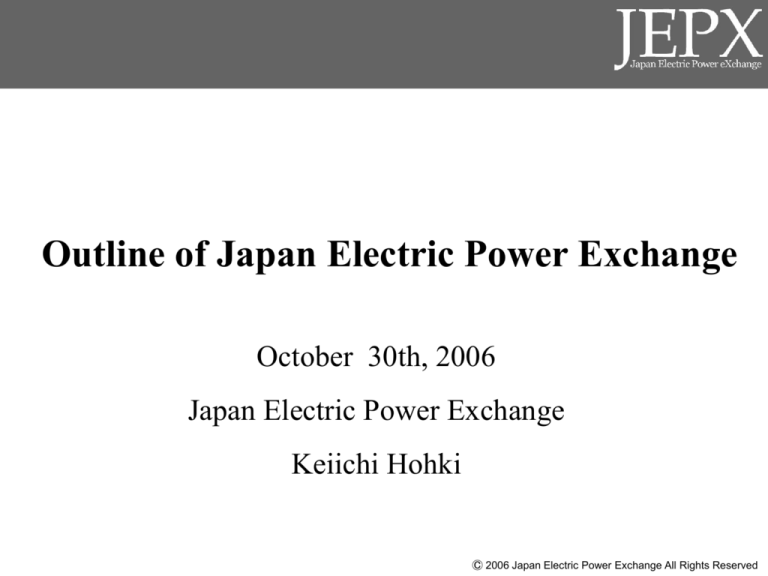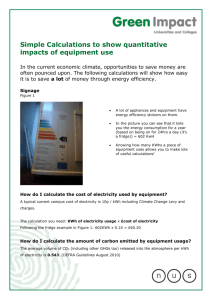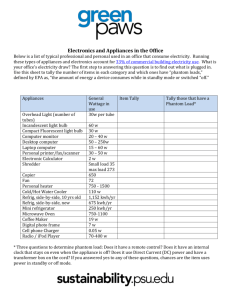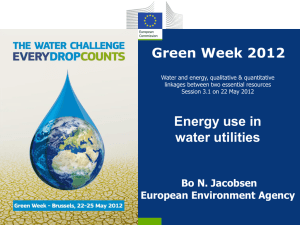
Outline of Japan Electric Power Exchange
October 30th, 2006
Japan Electric Power Exchange
Keiichi Hohki
-0-
Ⓒ 2006 Japan Electric Power Exchange All Rights Reserved
Contents
1. Japan's electric power systems
2. Japan's electricity industry
3. Outline of liberalization and roles of power exchange
4. Japan Electric Power Exchange
5. JEPX Markets
6. JEPX's track record to date
-1-
Ⓒ 2006 Japan Electric Power Exchange All Rights Reserved
• Changes in transmission systems used in Germany
between 1880 and 1935
100
80
60
(%)
A
40
B
C
D
20
0
1880
A
C
D
1890
Direct current
1900
1910
1920
1930
1935
B
Mixture of alternating and direct current
Single-phase alternating current
Multiphase alternating current (source) T.P.Hughes:”Networks of Power”
-2-
Ⓒ 2006 Japan Electric Power Exchange All Rights Reserved
Introduction to electric power industry
• Direct current tree-type transmission on an area basis
A Company
G G
B Company
G G
G
-3-
Ⓒ 2006 Japan Electric Power Exchange All Rights Reserved
Introduction to electric power industry
• Realization of long-distance alternating current transmission and
formation of networks
C Company(=A company + B company)
G G
G
-4-
G G
Ⓒ 2006 Japan Electric Power Exchange All Rights Reserved
Introduction to electric power industry
• Realization of economics of scale in electric power generation
C Company
G
G
-5-
Ⓒ 2006 Japan Electric Power Exchange All Rights Reserved
1. Japan's electric power systems
-6-
Ⓒ 2006 Japan Electric Power Exchange All Rights Reserved
1. Japan's electric power systems
• Country of Japan
Population (FY2004) : 128 million
Total land: 377,899.2 km2
Total electric energy sales
(FY2003): 834 TWh
Total system peak load (FY2003):
167 GW
Yearly average temperature *
(Tokyo):15.9℃
Average summer temperature *
(Tokyo, August): 27.1℃
Average winter temperature *
(Tokyo, January) : 5.8℃
* between FY1972 to FY2000
-7-
Ⓒ 2006 Japan Electric Power Exchange All Rights Reserved
1. Japan's electric power systems
• Japan's Tie Line between Regions
Hokkaido
AC (500kV)
AC (154kV~275kV)
DC
Conversion station
(FC, BTB, DC c/s)
60Hz
50Hz
Tohoku
Hokuriku
Tokyo
Chugoku
Kansai
Chubu
Kyushu
Shikoku
-8-
Ⓒ 2006 Japan Electric Power Exchange All Rights Reserved
1. Japan's electric power systems
• Demand
Japan is hot in summer and cold in winter. Because of such meteorological conditions, the
seasonal variations in electric demand are large, and the load curves are very steep. For
this reason, load factors are low.
The load curves of Japan's electric power companies basically look alike except for those
load curves of Hokkaido Electric Power Co., but they slightly differ, depending on the
difference in demand industry structures.
• Power source portfolio
There are almost no energy resources other than water power in Japan, and Japan's electric
power companies have constructed power source portfolios that allow for both energy
security and cost efficiency. For this reason, the contents of the power source portfolio are
similar but slightly different from company to company.
• Structures of transmission networks
Japan is a vertically long and narrow country composed of four major islands, and the
interconnection systems between electric power companies are skewer-shaped (they are
DC connected not to make loop systems).
The frequency of electricity is different between the eastern part and western part of Japan
(50 Hz in the eastern part and 60 Hz in the western part).
-9-
Ⓒ 2006 Japan Electric Power Exchange All Rights Reserved
1. Japan's electric power systems
• Power source portfolio
Hokkaido
Tohoku
Tokyo
Chubu
Hydroelectric
power
Hokuriku
Thermal power
Kansai
Nuclear power
Chugoku
Shikoku
Kyushu
0%
20%
40%
60%
80%
100%
Sweden
Hydroelectric
power
Thermal power
Nuclear power
Renewable
energy
Norway
Finland
Denmark
0%
20%
40%
60%
80%
100%
(the result of 2004)
-10-
Ⓒ 2006 Japan Electric Power Exchange All Rights Reserved
1. Japan's electric power systems
• Example of difference in daily demand curve
( Tokyo Electric Power Company vs France)
Demand curve on the day of yearly maximum demand
Normalized
demand
Tokyo(2001/7/24)
France(2001/12/17)
-11-
Ⓒ 2006 Japan Electric Power Exchange All Rights Reserved
1. Japan's electric power systems
• Comparison of yearly load factor
Tokyo Electric Power
Company
Chubu Electric Power
Company
Kansai Electric Power
Company
• Yearly load factor
59.8%
58.8%
57.0%
peak demand
P
Germany
France
England
77.2%
66.4%
67.0%
Total demand
(Total area)S
Time T(= one year)
The result of 2003, except Germany
S
Load factor =
P×T
-12-
Ⓒ 2006 Japan Electric Power Exchange All Rights Reserved
2. Japan's electricity industry
-13-
Ⓒ 2006 Japan Electric Power Exchange All Rights Reserved
2. Japan's electricity industry
• Pre-liberalization structure of electric power industry
Power generation
Transmission networks
Retail business
Consumer
-14-
Ⓒ 2006 Japan Electric Power Exchange All Rights Reserved
2. Japan's electricity industry
• The liberalization of the power market
Technological background of liberalization
– Due to advances in power-generation technology, such as gas turbines,
gas turbine combined-cycle systems, economy of scale does not
necessarily work in power generation.
Liberalization of the Japanese power market
– Regulations on new entries into power generation and retail business is
eliminated and the principle of competition is introduced.
– The monopoly in transmission, in which economy of scale is retained,
remains, but transmission networks are made accessible to users.
– From global perspective, form of the post-liberalization power market
is divided into Pool system and Third party access (TPA) market. Japan
adopted TPA market.
-15-
Ⓒ 2006 Japan Electric Power Exchange All Rights Reserved
2. Japan's electricity industry
• Liberalized power market
Third party-access (TPA) market
– A system in which third parties other than
electric utilities transmit power using
electric utilities ' networks.
– Retailers ensure supply capacity,
consistent with their demand curves, with
their own power sources or through
wholesale power transactions with other
power suppliers.
– Example
Germany,France, Japan, etc.
Power Producer
X electric
utilities
W
company
Z
company
X
electric utilities
(network sector)
X electric
utilities
Y
company
Z
company
Retailer
Consumer
-16-
Ⓒ 2006 Japan Electric Power Exchange All Rights Reserved
2. Japan's electricity industry
• Transactions in the TPA market
In most cases, a power exchange exists, and there are both transactions
through the exchange and bilateral transactions between counterparties.
Industry firms including power producers and retailers participate in the
exchange voluntarily, and conduct transactions to sell or buy electricity.
The exchange publishes agreed prices as market prices.
Electric
utility
Power
Producer
Power
Producer
Power
Producer
Internal
Power
Producer
Power
Producer
Power Exchange
procurement
Retailer
Retailer
Retailer
-17-
Retailer
Retailer
Ⓒ 2006 Japan Electric Power Exchange All Rights Reserved
2. Japan's electricity industry
April 2005 ~
March 2000~March 2005
(Power
generation)
Electric Power Exchange
Power
Power
producer producer
PPS
( Power
generation)
Other
Power
electric
producer
utilities
PPS
Electric utilities
Electric utilities
( network sector)
( network sector)
(Retail)
PPS
(Retail)
Consumer
regulated
Other
electric
utilities
PPS
Consumer
liberalized
regulated
-18-
liberalized(the expansion of
liberalization)
Ⓒ 2006 Japan Electric Power Exchange All Rights Reserved
3. Outline of liberalization and roles of power exchange
-19-
Ⓒ 2006 Japan Electric Power Exchange All Rights Reserved
3. Outline of liberalization and roles of power exchange
• Discussions on the liberalization of the electric power started in the early 1990.
Underlying the discussions are an increasing demand for eliminating
Japan's high cost structure and differences between domestic and
overseas prices of electricity and a trend for the deregulation of the
telecommunications and financial sectors.
• 1995
Regulations on new entries into wholesale electric business were
liberalized and competition was introduced.
• 2000
Competition was introduced into retail business targeting 2000 kW or
larger customers (about 30% of all customers in terms of kWh energy).
New entrants (newly established electricity supply firms (PPS)) use
networks through transmission services provided by electric utilities .
-20-
Ⓒ 2006 Japan Electric Power Exchange All Rights Reserved
3. Outline of liberalization and roles of power exchange
• Liberalization after April 2005
Expansion of liberalization of the retail power market: The liberalization
is expanded to 50 kW or larger customers (about 60% of all customers in
terms of kWh energy) → Discussion whether the liberalization should be
expanded to all customers is scheduled in 2007.
With the TPA-type market maintained, fairness and transparency is
ensured when third parties (new entrants) use networks owned by electric
utilities .
− Establishment of the Electric Power System Council of Japan (ESCJ)
− Conduct regulations imposed on electric utilities
A system to facilitate new entrants to procure power sources is introduced
− Development of a wholesale electric power exchange
→JEPX
-21-
Ⓒ 2006 Japan Electric Power Exchange All Rights Reserved
4. Japan Electric Power Exchange
-22-
Ⓒ 2006 Japan Electric Power Exchange All Rights Reserved
4. Japan Electric Power Exchange
• JEPX Profile (1/2)
Japan Electric Power Exchange (JEPX) was founded as a limited liability
intermediate corporation * on November 28, 2003, based on the purports of the
report “Framework of the Desirable Future Electricity Industry System"
presented by the Electricity Industry Committee of the Ministry of Economy,
Trade and Industry.
This corporation is aimed at fostering the interests common to the partners
thereof by opening and operating the wholesale electric power exchange that
mediates spot transactions and forward transactions of electricity.
* Intermediate corporation: a group that is not aimed at making profits but is aimed at
increasing the interests common to its members (partners).
-23-
Ⓒ 2006 Japan Electric Power Exchange All Rights Reserved
4. Japan Electric Power Exchange
• JEPX Profile (2/2)
[Partners]
[Trading members]
(those who operate the corporation and
are contributors of the fund)
(participant in transaction)
31 companies (September 2006)
21 companies (August 2005)
Electric utility
Electric utility
Wholesale electric company
9 companies
1 company
Power Producer and Supplier
(new entrants)
9 companies
Others
2 companies
Wholesale electric company
Power Producer and Supplier
(new entrants)
Others
9 companies
1 company
15 companies
6 companies
[Information members]
(those members who only peruse the information
on transactions)
29 (including corporations and individuals)
-24-
Ⓒ 2006 Japan Electric Power Exchange All Rights Reserved
4. Japan Electric Power Exchange
• Structure of JEPX
General meeting of partners
Auditors (2)
Board of directors (10)
Operational committee (21)
To discuss the operation of the exchange such as the establishment, revision
and abolition of the articles of incorporation, and the line of products.
Market monitoring committee (5)
To supervise the actions taken by traders in the market to ensure fair
transactions.
Liquidity assurance committee (5)
To verify the amount of input into this exchange by electric utilities for a
certain period (two years) after the opening of the exchange to ensure the
liquidity of market.
Administration office
Dispute settlement committee (5)
To arbitrate and settle disputes between members.
-25-
Ⓒ 2006 Japan Electric Power Exchange All Rights Reserved
4. Japan Electric Power Exchange
• Purposes of JEPX
JEPX is aimed at realizing the following purposes by operating a wholesale
electric power exchange.
To create price indicators that can be helpful in judging a risk of investment
in power sources.
To form market prices of electric power, which reflect demand-and-supply positions
that fluctuate with seasons and time periods.
To provide an arena where excess and deficiency of power sources can be
adjusted through transactions between electric power companies.
Individual firms have their respective load curves of different shapes. Therefore, it
will be possible to use power sources more efficiently overall, if they make up for
excess or deficiency of supply capacity with each other through the exchange.
-26-
Ⓒ 2006 Japan Electric Power Exchange All Rights Reserved
4. Japan Electric Power Exchange
• Policy of transactions
Place to Trade Electricity as Physical goods
Japan Electric Power Exchange is a place to match the demand for and supply of
electricity as physical goods. It does not assume such transactions and settlements
by means of financial instruments.
• Markets
JEPX provides the following three nationwide markets.
Spot
Market
The place to trade the electricity that will be delivered on the following day.
Forward Fixed-Form
Market
The place to trade the electricity that will be delivered after a certain period of time.
Forward Bulletin
Board Market
The place to make transactions by freely posting messages on the bulletin board.
-27-
Ⓒ 2006 Japan Electric Power Exchange All Rights Reserved
4. Japan Electric Power Exchange
• Principles of Transactions
1. Prevention of market manipulation
Unfair transactions such as price manipulation, interference in transactions,
occupation of interconnection lines, etc. are prevented.
2. Ensuring of liquidity (vitalization of transactions)
The ensuring of liquidity is aimed at improving the usability for traders. It is also
effective to ensure operating revenues of the exchange and to prevent market
manipulation.
3. Ensuring of stable electricity supply
To ensure the stable supply of electricity, places of power generation and delivery
are specified for every transaction.
[Supervision of Transactions and Penalty]
Transactions are supervised based on the rules of the exchange to avoid any unfair transaction.
Penalties are imposed on any violation of the rules.
-28-
Ⓒ 2006 Japan Electric Power Exchange All Rights Reserved
4. Japan Electric Power Exchange
• Way of Transaction
Each member is required to make all transactions respective markets through JEPX's computer system. The notices
of acceptance of solicitations for bids and that of contracts concluded are provided by the computer system. For
participation, each member is required to create an environment to access the Internet.
JEPX's computer system and access image
Member
JEPX
API connection
System on the member side
JEPX's computer system
Web connection
Use of the screen provided by JEPX
-29-
Ⓒ 2006 Japan Electric Power Exchange All Rights Reserved
5. JEPX Markets
-30-
Ⓒ 2006 Japan Electric Power Exchange All Rights Reserved
5. JEPX Markets
① Spot Market
Products
・ In proportion to 30 minutes as the minimum unit of balancing and measuring, 48 products are
traded every 30 minutes in 24 hours a day.
・ The minimum volume of bid is set at 1MW in increments of 30 minutes (= 500 kWh).
Way of Matching
・ Matching is conducted by a single price auction.
・ When tie line are congested, the market is split, and matching is conducted in each split market.
Compensation due to Generator Malfunction
・ JEPX mediates a buyer's claim to be paid by a seller for damages in case the seller's generator
causes a malfunction. For this purpose, a "seller (power generator)" and a "buyer (power
supplier)" are matched with each other on the system.
-31-
Ⓒ 2006 Japan Electric Power Exchange All Rights Reserved
5. JEPX Markets
• Single Price Auction(1/2)
Seller's respective curves that represent
selling bids
Buyer's respective curves that represent
buying bids
\/MWh
\/MWh
MW
Composite buying
curve
Composite selling
curve
MW
\/MWh
\/MWh
MW
MW
-32-
Ⓒ 2006 Japan Electric Power Exchange All Rights Reserved
5. JEPX Markets
• Single Price Auction(2/2)
Price
"Selling" bid data
When tie line are congested,
the market is divided, and
matching is conducted in
each split market.
Aggregate
Bids from participants
Agreed price
The volume to be "sold" and that to be
"bought" are matched at a certain price.
"Buying" bid data
Volume
-33-
Ⓒ 2006 Japan Electric Power Exchange All Rights Reserved
5. JEPX Markets
•Market Splitting (1/2)
Region 2
Region 1
Composite
selling
System
price P
\/MWh
\/MWh
3 MW bought
Composite
buying
0 MW bought
P
P
3
MW
\/MWh
3 MW sold
P
3
3
3 MW flows from Region 1
to Region 2, which exceed
the interconnection line's 1
MW capacity.
MW
\/MWh
P
0 MW sold
3
-34-
MW
MW
Ⓒ 2006 Japan Electric Power Exchange All Rights Reserved
5. JEPX Markets
•Market Splitting (2/2)
Region 1
\/MWh
1 MW bought
P1
Region 2
The price is adjusted to reduce
the amount of electricity that
flows to its interconnection line
capacity of 1 MW by decreasing
the price in Region 1 and
increasing the price in Region 2.
\/MWh
2 MW bought
P2
MW
1
As a result, the price in Region
1 becomes P1 (<P).
\/MWh
2 MW sold
P1
2
2
The price in Region 2 becomes
P2 (>P).
\/MWh
1 MW sold
P2
MW
1
-35-
MW
MW
Ⓒ 2006 Japan Electric Power Exchange All Rights Reserved
5. JEPX Markets
② Forward Fixed-Form Market
•
The forward fixed-form market deals with electricity transactions to be delivered in one month or one week
period starting in two weeks later to one year ahead.
•
The forward fixed-form market has four products depending on the period and pattern of electricity delivery:
“Monthly 24-hour type product,” “Weekly 24-hour type product,” “Monthly daytime type product,” and
“Weekly daytime type product.”
•
Monthly 24-hour type product
Delivers certain amount of
electricity constantly for one
month.
•
Monthly daytime type product
Delivers electricity between 8 a.m.
and 10 p.m. on all delivery days
except Saturday, Sunday, national
holiday and holidays designated by
PX.
8 a.m.
22 p.m. 8 a.m.
22 p.m. 8 a.m.
22 p.m.
No delivery
on Saturday
& Sunday
・・・
Weekly products which deals with one week electricity delivery starting two weeks later to nine weeks
later are also available.
・ Matching is done by continuous sessions.
・ Participants are allowed to set terms and conditions of authorizing credits for other participants.
-36-
Ⓒ 2006 Japan Electric Power Exchange All Rights Reserved
5. JEPX Markets
• Matching in Continuous Session at JEPX
Selling
45MW
35MW
500MW
20MW
In the case of an ordinary
continuous session, the bidding
data displayed in boldface type
are immediately contracted and
excluded from the session. In
the case of JEPX, such data
might remain in the session
because of restrictions on
interconnection lines, etc.
Buying
8.01 yen
7.78 yen
7.77 yen
7.03 yen
6.89 yen
6.66 yen
6.50 yen
20MW
200MW
300MW
New bid
Selling: 6.50 yen, 30 MW
New bids are matched with higher priority
given to prices, after the conditions of credit
authorization and the possibility of
interconnection transmission are checked.
-37-
Ⓒ 2006 Japan Electric Power Exchange All Rights Reserved
5. JEPX Markets
③ Bulletin Board
Image of bulletin board (in case of sale of power)
Selling
Nippon Electric Power Co.
Some room is left
for the parties to
negotiate with
each other.
Phone No. 03-XXXX-XXXX (contact Sato)
July 1, 2006 – August 31, 2006
"Fixed-price +
as-used price"
type
Up to 17 MW, 1,700 MWh
Area: Tokyo
kW price: 1,000 yen per kW kWh price: 10.00 yen per kWh
Special remarks
-38-
Ⓒ 2006 Japan Electric Power Exchange All Rights Reserved
6. JEPX's track record to date
-39-
Ⓒ 2006 Japan Electric Power Exchange All Rights Reserved
6. JEPX's track record to date
•Outline of Transactions Made to Date (1/4)
Total contract volume
FY2005
Spot transactions(kWh)
Forward transactions
(kWh)
Total (kWh)
Apr
14,224,000
364,000
14,588,000
May
22,598,500
8,260,000
30,858,500
Jun
28,731,500
3,150,000
31,881,500
Jul
17,442,000
1,890,000
19,332,000
Aug
39,762,000
0
39,762,000
Sep
64,086,000
0
64,086,000
Oct
104,469,500
7,200,000
111,669,500
Nov
123,574,000
336,000
123,910,000
Dec
175,928,500
51,796,000
227,724,500
Jan
168,496,000
74,518,000
243,014,000
Feb
117,285,500
2,912,000
120,197,500
Mar
61,652,500
0
61,652,500
Total
938,250,000
150,426,000
1,088,676,000
-40-
Ⓒ 2006 Japan Electric Power Exchange All Rights Reserved
6. JEPX's track record to date
•Outline of Transactions Made to Date (2/4)
Total contract volume
Spot transactions
(kWh)
FY2006
Forward transactions
(kWh)
Total
(kWh)
Apr
76,301,000
1,540,000
77,841,000
May
115,465,000
728,000
116,193,000
Jun
127,014,500
49,000,000
176,014,500
Jul
176,701,000
52,360,000
229,061,000
Aug
172,670,500
0
172,670,500
Sep
104,189,000
70,000
104,259,000
Total
772,341,000
103,698,000
876,039,000
-41-
Ⓒ 2006 Japan Electric Power Exchange All Rights Reserved
6. JEPX's track record to date
•Outline of Transactions Made to Date (3/4)
Average volume of spot transactions contracted per day and average system price
Average volume
contracted per day
(10,000 kWh per day)
FY2005
Average system price (yen per kWh)
24-hour average
Daytime average
(8:00 a.m. to 10:00 p.m.)
Peak time average
(1:00 p.m. to 4:00 p.m.)
Apr
49
8.06
8.52
8.83
May
73
7.69
8.55
8.90
Jun
96
8.53
9.72
10.71
Jul
56
8.33
10.48
12.07
Aug
128
8.47
10.89
13.19
Sep
214
7.70
9.64
10.97
Oct
337
7.82
9.03
9.55
Nov
412
8.44
9.29
9.43
Dec
568
11.03
12.08
12.11
Jan
544
13.95
15.50
15.35
Feb
419
14.09
16.09
16.38
Mar
199
8.60
9.71
10.29
Overall
258
9.37
10.77
11.47
-42-
Ⓒ 2006 Japan Electric Power Exchange All Rights Reserved
6. JEPX's track record to date
•Outline of Transactions Made to Date (4/4)
Average volume of spot transactions contracted per day and average system price
Average volume
contracted per day
(10,000 kWh per day)
FY2006
Average system price (yen per kWh)
24-hour average
Daytime average
(8:00 a.m. to 10:00 p.m.)
Peak time average
(1:00 p.m. to 4:00 p.m.)
Apr
254
8.24
9.26
10.07
May
372
8.22
9.66
10.98
Jun
423
8.23
9.66
10.99
Jul
570
8.01
9.97
11.79
Aug
557
9.03
11.57
14.45
Sep
347
8.45
10.52
12.30
Overall
422
8.37
10.11
11.78
-43-
Ⓒ 2006 Japan Electric Power Exchange All Rights Reserved
6. JEPX's track record to date
•Changes in Weekly Average of Contract Volume of Spot Transactions and System Prices
(¥/kWh)
Weekly average of daily contract volume and system price
(million kWh/day)
20.00
9
Weekly average of contract volume
Peak time average
Daytime average
24-hour average
18.00
16.00
8
7
14.00
6
12.00
5
10.00
4
8.00
3
6.00
2
4.00
1
0.00
0
2Fr
om
16
Ap
r
-A
pr
30
-A
14 pr
-M
a
28 y
-M
a
11 y
-J
u
25 n
-J
un
9Ju
23 l
-J
u
6- l
Au
20 g
-A
ug
3Se
17 p
-S
ep
1O
c
15 t
-O
c
29 t
-O
12 ct
-N
o
26 v
-N
o
10 v
-D
e
24 c
-D
ec
7Ja
21 n
-J
an
4Fe
18 b
-F
eb
4M
a
18 r
-M
ar
1Ap
15 r
-A
p
29 r
-A
13 pr
-M
a
27 y
-M
a
10 y
-J
u
24 n
-J
un
8Ju
22 l
-J
ul
5Au
19 g
-A
ug
2Se
16 p
-S
ep
2.00
-44-
Ⓒ 2006 Japan Electric Power Exchange All Rights Reserved
6. JEPX's track record to date
•Changes in Contract Volume of Spot Transactions and Prices (Daily Basis)
Daily contract volume by day and system price
(¥/kWh)
(m illion kW h/day)
25.00
12
Contract volume
24-hour average
Daytime average
Peak time average
11
10
20.00
9
8
15.00
7
6
5
10.00
4
3
5.00
2
1
-45-
06
/9
06
/8
06
/7
06
/6
06
/5
06
/4
06
/3
06
/2
06
/1
05
/1
2
05
/1
1
05
/1
0
05
/9
05
/8
05
/7
05
/6
0
05
/5
05
/4
0.00
Ⓒ 2006 Japan Electric Power Exchange All Rights Reserved
6. JEPX's track record to date
•Outline of Results of Forward Fixed-Form Transactions (by Product, FY)
Monthly FY2005
Daytime type
The
number
Total volume
of contracts
5
7,280,000
Jun
24hour type
Price
(Ave.)
11.96
The
number
Total volume
of contracts
Price
(Ave.)
-
-
-
Jul
3
3,150,000
16.33
-
-
-
Aug
1
1,890,000
15.40
-
-
-
Sep
1
1,344,000
13.75
-
-
-
-
-
-
Oct
-
-
-
Nov
-
-
-
1
-
7,200,000
-
8.40
-
Dec
1
336,000
11.71
Jan
3
18,676,000
12.87
1
29,760,000
11.05
Feb
9
44,758,000
14.06
1
3,360,000
10.62
Mar
1
2,912,000
16.40
1
29,760,000
14.05
Total
24
80,346,000
13.80
4
70,080,000
11.03
-46-
Total volume of contracts
concluded
The number of contracts
concluded: 28
Total volume of
contracts:150,426,000
kWh
Price(Ave.):
13.40 yen/kWh
Ⓒ 2006 Japan Electric Power Exchange All Rights Reserved
6. JEPX's track record to date
•Outline of Results of Forward Fixed-Form Transactions (by Product, FY2006)
Monthly FY2006
Daytime type
Apr
24hour type
The
number
Total volume
of contracts
Price
(Ave.)
The
number
Total volume
of contracts
Price
(Ave.)
Total volume of contracts
concluded
-
-
-
-
-
-
May
1
1,540,000
12.26
-
-
-
Jun
1
728,000
12.20
-
-
-
The number of contracts
concluded: 2
Total volume of
contracts:2,268,000
kWh
Jul
-
-
-
-
-
-
Price(Ave.):
Aug
-
-
-
-
-
-
12.23 yen/kWh
Sep
-
-
-
-
-
-
12.23
-
-
-
Total
2
2,268,000
-47-
As of 30-Sep
Ⓒ 2006 Japan Electric Power Exchange All Rights Reserved
6. JEPX's track record to date
•Outline of Results of Forward Fixed-Form Transactions (by Product, FY)
Weekly FY2006
Daytime type
24hour type
The
number
Total volume
of contracts
Price
(Ave.)
The
number
Total volume
of contracts
Price
(Ave.)
07/01 ~
07/07
-
-
-
1
10,080,000
07/08 ~
07/14
-
-
-
4
31,920,000
10.95
07/15 ~
07/21
-
-
-
3
16,800,000
11.05
07/22 ~
07/28
2
14,000,000
17.97
4
28,560,000
13.68
10/14~
10/20
1
70,000
12.21
-
-
-
Total
3
14,070,000
16.05
12
87,360,000
11.85
Total volume of contracts
concluded
10.50
The number of contracts
concluded: 15
Total volume of
contracts:101,430,000
kWh
Price(Ave.):
12.69 yen/kWh
As of 30-Sep
-48-
Ⓒ 2006 Japan Electric Power Exchange All Rights Reserved
Comparative table of Electric Power Exchange
Powernext
EEX
NordPool
PJM
JEPX
(France)
(Germany)
(Northern Europe)
(USA)
(Japan)
Form of organization
Private limited company
Joint-stock corporation
Private limited
company
Private limited
company
Limited liability
intermediate
corporation
Listed goods
Spot,Future
Spot,Future, Options
Spot, Future,Forward,
Options
Spot, Real-time
Spot,Forward
Member
Power generator,
Retailer,Marketer,
Major customers
Power generator, Retailer, Power generator,
Marketer, Major
Retailer, Marketer,
customers
Major customers
Power generator,
Power generator,
Retailer,
Retailer,
(88 Members)
(150 Members)
Marketer, etc.
Broker, etc.
(428 Members)
(31 Members)
About 0.8 billion yen
( Transmission
network industry
firms, etc.)
About 0.1 billion
yen
1 billion yen
0.45 million yen
0.18 million yen
0.1 million yen
(Size of member in Spot
market)
(339 Members)
Capital
About 1.2 billion yen
unknown
(Major partner)
(Exchange industry
firms,NW operator,
Power generator ,
Retailer)
( Exchange industry firm,
financial institution,
Electricity industry ,
Local government, etc)
-
( Members of
PJM)
( 21 partners of
JEPX)
Entrance fee
3.3 million yen
Annual fee
3.9 million yen
1.6 million yen
1.6 million yen
0.6 million yen
0.5 million yen
Selling and buying fees
(spot transaction)
0.011 yen/kWh
0.004 yen/kWh
0.004 yen/kWh
unknown
0.03 yen/kWh
(including clearing fee)
-49-
Ⓒ 2006 Japan Electric Power Exchange All Rights Reserved
Volume of Transactions Predicted at the Time of Solicitation
to Fund (2004)
The amount of transactions estimated by a research agency last year based on a questionnaire to the
participants is shown below. Though the evaluation only four months after the commencement of
transactions seems to be premature, the changes in the volume of transactions to date are very close to
that prescribed by Standard Scenario.
by way of the exchange
Volume of transactions
取引所経由取引量(億kW
h) (100 million
kWh)
Predicted changes
in the volume of transactions
取引量推移予測
40
Standard
Scenario
オ
標準シナリ
35
Pessimistic Scenario
悲観シナリオ
30
(33% downward
value)
(下方33%値)
25
20
15
10
Actual Volume
5
0
1年目
1st
year
2年目
2nd
year
3年目
3rd
year
4年目
4th
year
5年目
5th
year
6年目
6th
year
7年目
7th
year
8年目
8th
year
Standard Scenario: 360 million kWh (the average volume of transactions per day is 1 million kWh) in the first year, and
the volume is expected to reach 4 billion kWh per year (the break-even point) in the sixth year.
-50-
Ⓒ 2006 Japan Electric Power Exchange All Rights Reserved
Short History
of the Japan Electric Power Exchange (JEPX)
The Japan Electric Power Exchange (JEPX) was established following a report presented by the Electricity Industry
Subcommittee of the Advisory Committee on Natural Resources and Energy in February 2003, which recommended
the development of a market for nationwide wholesale electricity transactions.
Date
Japan Electric Power Exchange (JEPX)
Electricity Industry Subcommittee of the Advisory Committee on
Natural Resources and Energy
Report on the “Framework of the Desirable Future Electricity Industry
System”
February 2003
July 2003
September 2003
October 2003
November 2003
Inauguration of the Preparatory Committee for Establishment (18
companies)
First explanatory meeting for participating companies held
Second explanatory meeting for participating companies held
Registration for incorporation (21 companies)
Interim report on the “Detailed Design of the Desirable Future
Electricity Industry System”
December 2003
March 2004
Third explanatory meeting for participating companies held
Report on the “Detailed Design of the Desirable Future Electricity
Industry System”
May 2004
June 2004
August 2004
September 2004
January 2005
April 2005
Fourth explanatory meeting for participating companies held
Relocation and incorporation (location: Shibaura, Minato-ku)
Fifth explanatory meeting for participating companies held
Establishment of transaction rules completed
Commencement of transactions
-51-
Ⓒ 2006 Japan Electric Power Exchange All Rights Reserved









